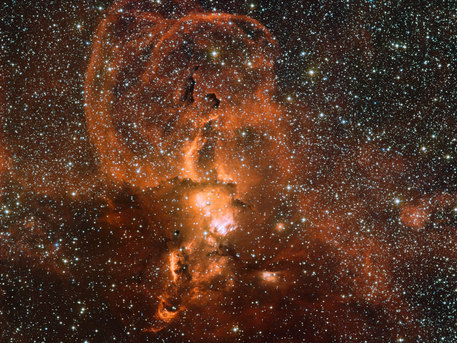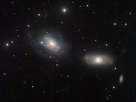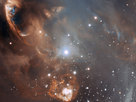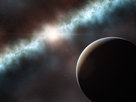nebula NGC 3582
Celestial Fireworks from Dying Stars
 © @ESO
|
Image of the nebula NGC 3582
Some of the stars forming in regions like NGC 3582 are much heavier than the Sun. These monster stars emit energy at prodigious rates and have very short lives that end in explosions as supernovae. The material ejected from these dramatic events creates bubbles in the surrounding gas and dust. This is the probable cause of the loops visible in this picture.
This image was taken through multiple filters. From the Wide Field Imager, data taken through a red filter are shown in green and red, and data taken through a filter that isolates the red glow characteristic of hydrogen are also shown in red. Additional infrared data from the Digitized Sky Survey are shown in blue.
The image was processed by ESO using the observational data identified by Joe DePasquale, from the United States [1], who participated in ESO’s Hidden Treasures 2010 astrophotography competition [2]. The competition was organised by ESO in October–November 2010, for everyone who enjoys making beautiful images of the night sky using astronomical data obtained using professional telescopes.
Notes
[1] Joe searched through ESO’s archive and identified datasets that he used to compose his image of NGC 3582, which was the tenth highest ranked entry in the competition, out of almost 100 entries
[2] ESO’s Hidden Treasures 2010 competition gave amateur astronomers the opportunity to search through ESO’s vast archives of astronomical data, hoping to find a well-hidden gem that needed polishing by the entrants.
Source: ESO
nebula NGC 3582
Celestial Fireworks from Dying Stars
 © @ESO
|
Image of the nebula NGC 3582
Some of the stars forming in regions like NGC 3582 are much heavier than the Sun. These monster stars emit energy at prodigious rates and have very short lives that end in explosions as supernovae. The material ejected from these dramatic events creates bubbles in the surrounding gas and dust. This is the probable cause of the loops visible in this picture.
This image was taken through multiple filters. From the Wide Field Imager, data taken through a red filter are shown in green and red, and data taken through a filter that isolates the red glow characteristic of hydrogen are also shown in red. Additional infrared data from the Digitized Sky Survey are shown in blue.
The image was processed by ESO using the observational data identified by Joe DePasquale, from the United States [1], who participated in ESO’s Hidden Treasures 2010 astrophotography competition [2]. The competition was organised by ESO in October–November 2010, for everyone who enjoys making beautiful images of the night sky using astronomical data obtained using professional telescopes.
Notes
[1] Joe searched through ESO’s archive and identified datasets that he used to compose his image of NGC 3582, which was the tenth highest ranked entry in the competition, out of almost 100 entries
[2] ESO’s Hidden Treasures 2010 competition gave amateur astronomers the opportunity to search through ESO’s vast archives of astronomical data, hoping to find a well-hidden gem that needed polishing by the entrants.
Source: ESO









